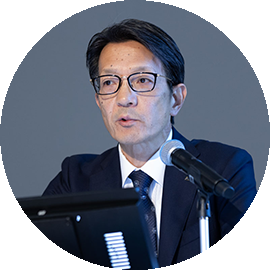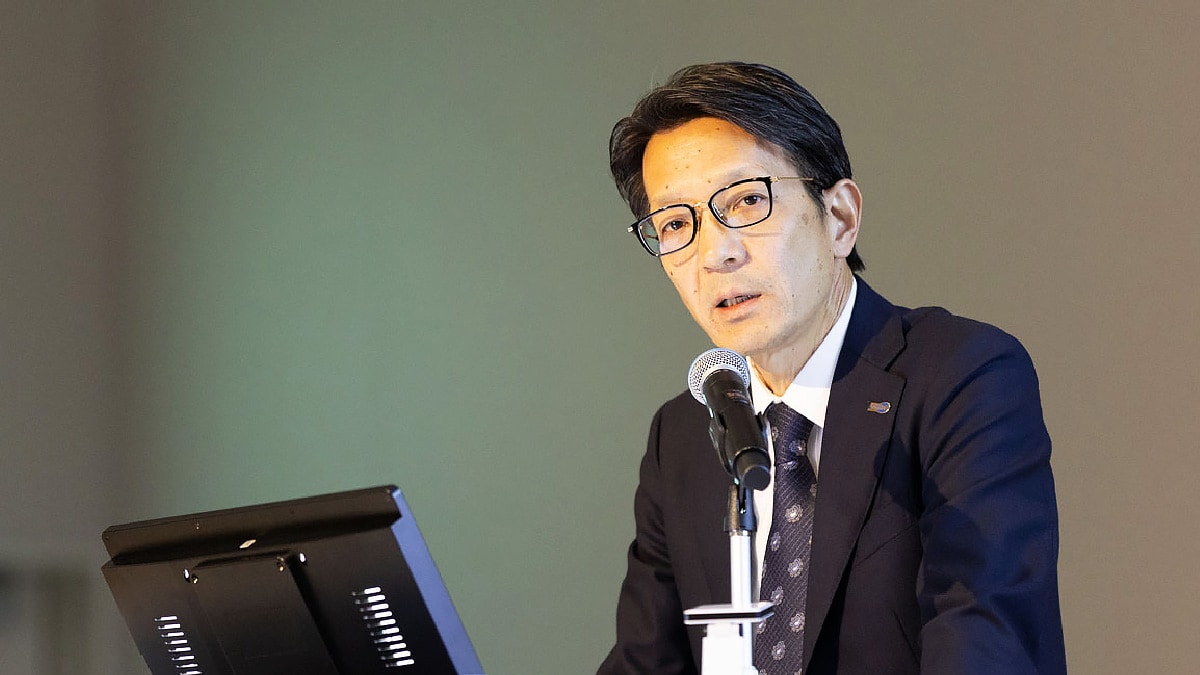The International Electric Vehicle Technology Conference (EVTeC) is an international conference focusing on EV technology, which started in 2011 by the Society of Automotive Engineers of Japan (JSAE). In May 2023, the 6th EVTeC was held in Yokohama, and Keiji Otsu, President and Representative Director of Honda R&D Co., Ltd. delivered a speech titled “Honda's Vision for Carbon Neutrality in 2050.”
What is Honda's vision for the realization of carbon neutrality? Here is the brief summary of the speech session by Otsu, which covered a broad range of subjects including electrification, hydrogen utilization and energy circulation.

President and Representative Director
Honda R&D Co., Ltd.
View More
Close
Keiji Otsu
Read More
Using MPPs with a bucket-brigade approach will accelerate the realization of carbon neutrality
The EVTeC 2023 was held at Pacifico Yokohama in Japan for three days from May 22 to 24. Otsu took the stage on the final day of the event and delivered a speech titled “Honda's Vision for Carbon Neutrality in 2050.”
 All speeches at EVTeC were delivered in English.
All speeches at EVTeC were delivered in English.
Otsu began his speech by stating that “Honda has been committed to helping people through its products and technologies since its founding,” mentioning challenges Honda has taken in the areas of F1 racing and automated driving. He then said, “The willingness to take on challenges in order to help people is in Honda DNA. Our purpose is to help people, and technology is the means to achieve that purpose.”
As a company that helps people and society, Honda has continued to grow in a broad range of businesses, but now, not only the automobile industry, the entire society is in the midst of a major change which requires commitment to address environmental issues.
Otsu explained Honda’s 2050 environmental target, then went on to reiterate that Honda is taking initiative in three interrelated focus areas, namely “carbon neutrality,” “clean energy” and “resource circulation” to achieve the 2050 target.

We call these initiatives ‘Triple Action to ZERO,’ meaning corporate activities aiming for ‘zero environmental impact’ throughout the product lifecycle.
 Honda’s “Triple Action to ZERO” initiative
Honda’s “Triple Action to ZERO” initiative
First, Otsu explained “carbon neutrality” and “clean energy.”

Electrification requires further advancement of various technological elements, the most important of which is the battery. Current batteries still have some issues including range and cost. To address such issues, we must increase energy density. To this end, Honda is making progress in the development of all-solid-state batteries, with which we are striving to create affordable and long-range EVs.

We are developing both cell stack* specifications and the battery production process simultaneously so that our all-solid-state battery research will move smoothly to the production stage in the future. In fact, the demonstration line where our production technologies will be tested prior to mass production is scheduled to become operational in 2024.
*A stack of parts (cells) that generate electrical energy
 Overview of the all-solid-state battery currently under development
Overview of the all-solid-state battery currently under development

In order to further electrify our society, we must realize a “clean society” by creating a link between the electrification of mobility products and use of renewable energy.
In his speech, Otsu introduced one of the initiatives Honda has been taking toward this direction: expansion of the use of Honda Mobile Power Packs (MPPs). When the use of swappable battery packs becomes widespread, there will be a structure that enables people to carry around electricity derived from renewable energy sources for their mobility products and daily lives, just like a “bucket brigade” for electricity.

By separating the batteries from the products, it becomes possible for people to share batteries within a household, which will reduce the cost of batteries and increase the battery utilization rate, which leads to more efficient use of resources.
 Honda MPP swappable battery pack
Honda MPP swappable battery pack
However, this alone is not enough to achieve carbon neutrality by 2050. In his speech, Otsu also introduced Honda initiatives related to “hydrogen energy,” which Honda positions as one of the key energy carriers along with electricity.
The electricity-hydrogen “energy mix” will be the key

Electricity is economical and a versatile energy carrier because it enables people to directly utilize energy generated from renewable energy sources. Hydrogen has a higher energy density than electricity and can be stored for long periods of time. Therefore, Honda is envisioning the pursuit of the “energy mix” that leverages advantages of both electricity and hydrogen.
Otsu then introduced the next-generation fuel cell system that will be installed in Honda's next-generation FCEV (fuel cell electric vehicle).
 Overview of the next-generation fuel cell system
Overview of the next-generation fuel cell system
With this next-generation fuel cell system, the cost was reduced to one-third and the durability was more than doubled compared to the previous version, and low temperature resistance was also increased.

Hydrogen can store and transport energy at high density and fill the tank quickly.
Therefore, I believe that we should take a more proactive approach to the utilization of hydrogen as a power source for heavily used large-size mobility products and key infrastructure.
Based on this belief, Honda is making progress in applying FC stacks to commercial trucks and conducting demonstration testing in various locations inside and outside Japan.
New technology to reduce CO2 emissions by producing fuel from recovered CO2
Toward the end of his speech session, Otsu posed one question.

Aren't you all wondering if the use of renewable energy will really be popularized in our society as we planned?
Otsu put one slide on the screen: the Japanese government's Sixth Strategic Energy Plan approved by the Cabinet in October 2021.
 Overview of the Japanese government’s Sixth Strategic Energy Plan which included the projection that 41% of the power generation would still be from fossil fuels as of FY2030.
Overview of the Japanese government’s Sixth Strategic Energy Plan which included the projection that 41% of the power generation would still be from fossil fuels as of FY2030.

According to the 2030 projection included in this government’s plan, renewable energy sources will account for 36-38%, nuclear power for 20-22% and fossil fuels for 41%. This means that even if EVs and hydrogen achieve widespread use throughout society, carbon neutrality cannot be achieved as long as there are production processes, including recycling and resource circulation, that use electricity. So, whether or not we can achieve carbon neutrality depends on how we can increase the use of electricity and hydrogen that can be generated without emitting CO2.
 Otsu discussed company-wide challenges toward the realization of carbon neutrality.
Otsu discussed company-wide challenges toward the realization of carbon neutrality.
In order to strive for the realization of a circular/resource-recycling society which aims for zero environmental impact not only for the products but for the entire product lifecycle, Honda must not only eliminate CO2 emissions from its cars and motorcycles, but also from factories and offices.
As one of the initiatives Honda is taking to this end, Otsu introduced the Direct Air Capture (DAC) system, a technology to separate and capture CO2 from the atmosphere using a container unit which contains CO2 adsorbent. The recovered CO2 will be mixed with hydrogen using a catalyst to transform it into a fuel.
 Overview of the DAC system
Overview of the DAC system

This technology is still in the research phase, and we are working on it with an eye toward real-world applications in the future.
Another initiative Otsu introduced in this speech was “resource circulation,” which is one of the focus areas of the Triple Action to ZERO.
Currently, a large amount of CO2 emissions are coming from the use of fossil fuels. However, as the number of electrified products and the amount of electricity derived from renewable energy sources increase in the future, the proportion of CO2 emissions from activities related to the procurement of raw materials will increase. When this happens, recycling of raw materials and effective utilization of resources will become important to reduce CO2 emissions throughout the lifecycle of the products. This is the concept of Honda’s “resource circulation.”

Currently, approximately 90% of the parts used in automobiles are made of virgin materials. When the vehicle reaches the end of its lifecycle, approximately 70% of the materials are recycled. However, the recycled materials do not return to the automotive industry; they are used in other industries. To realize sustainable automobile production, the ratio of resource circulation must be increased. To this end, Honda is striving to develop resource circulation systems and technologies and make changes to vehicle designs and specifications.
In his speech session, Otsu also introduced some initiatives Honda is currently taking in new areas such as space technology and eVTOL. The realization of carbon neutrality is not the only dream Honda has. Honda is dreaming of enabling people to transcend the constraints of time and place and play active roles in society.

We are undergoing a period of great transformation, but Honda will continue to take on challenges and contribute to society with its technologies.
Original article issued on July 7, 2023







Honda wants to realize a circular/resource-recycling society which aims for zero environmental impact, so that people can live sustainably on Earth.